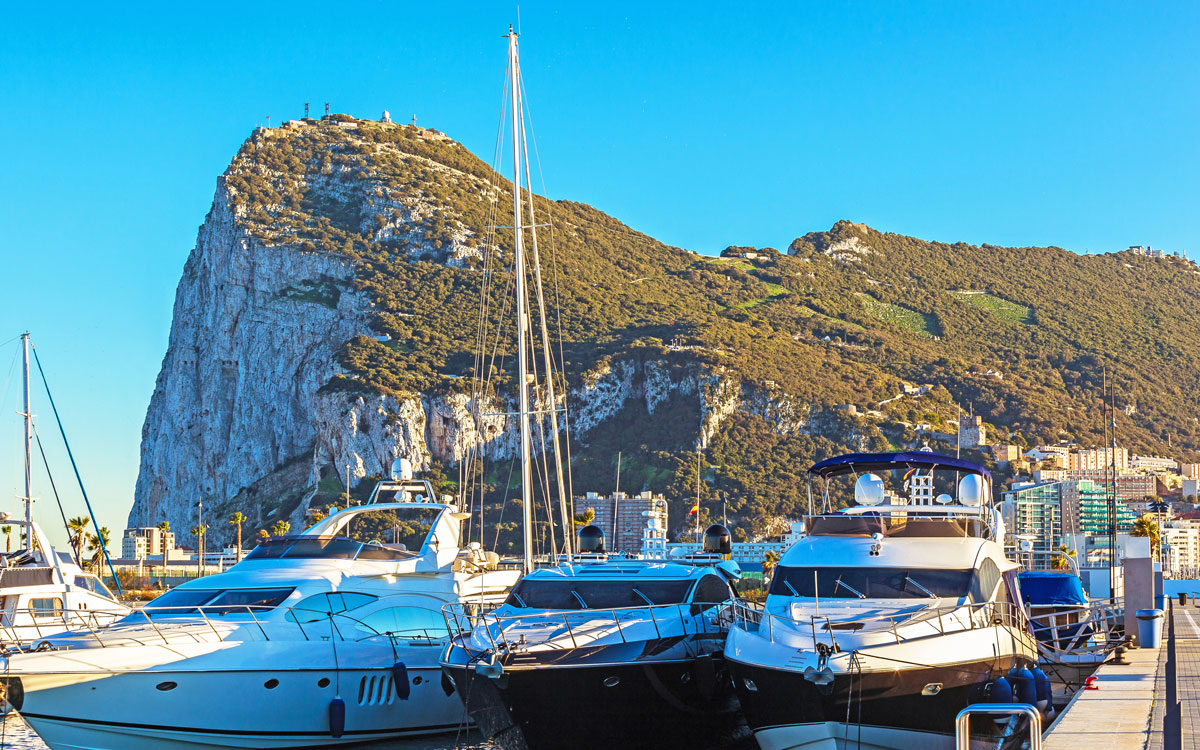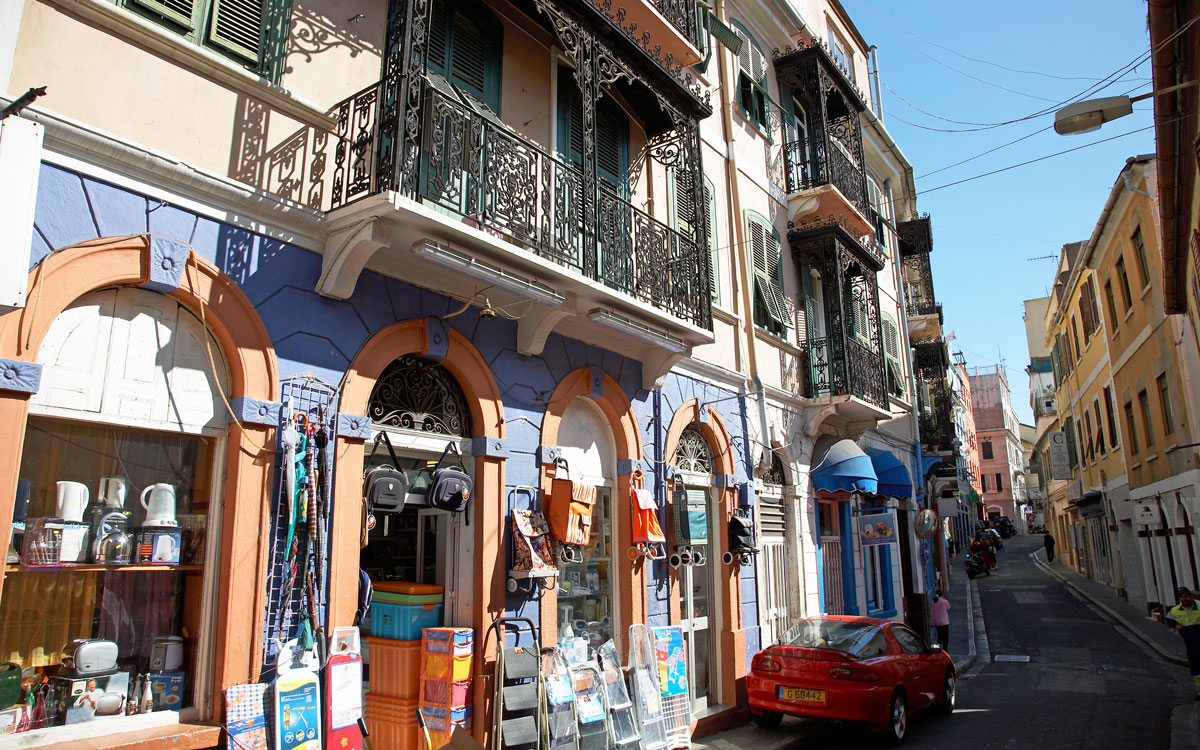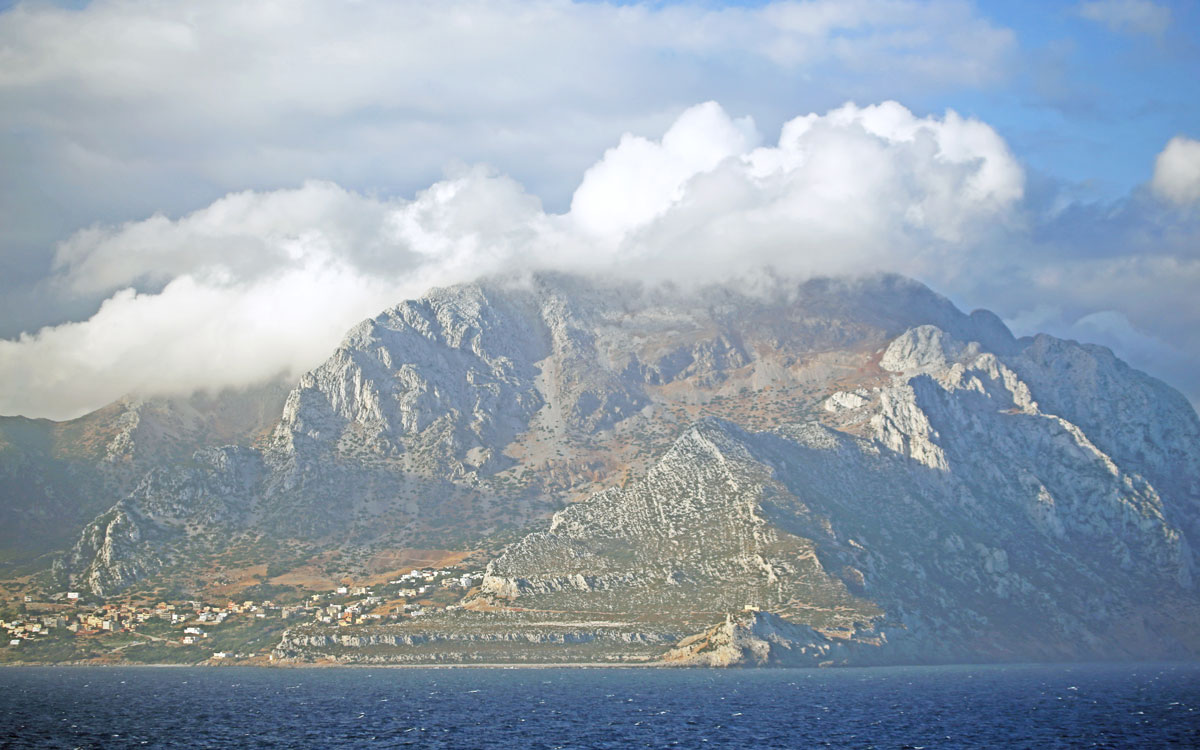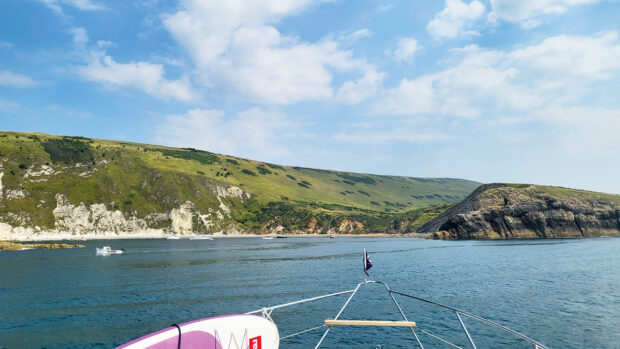This rocky outpost of the UK isn’t just a gateway to the Mediterranean – Gibraltar is also an excellent cruising base from which to explore the surrounding area
The far west end of the Mediterranean has an aura of expectation and transition. Passing through the Strait of Gibraltar in either direction, you feel a sense of new experiences waiting round the next headland. Outside this famous shipping gap is the restless Atlantic, beckoning adventurers towards empty horizons. Inside stands the stunning rocky outcrop of Gibraltar which, together with Mount Sidi Musa at the tip of Morocco, forms the classical gateway to the Middle Sea – one of the great Pillars of Hercules in Greek mythology.
Gibraltar is a fantastic limestone anomaly opposite the hot Spanish hillsides of Algeciras, towering 1,400ft above the blue waters of a spectacular bay. At its south tip, the red and white lighthouse on Europa Point is a strategic and romantic landmark for countless ships bound between the Atlantic and the Med.
A dozen miles to the south, mysterious Morocco looms in and out of focus, its mountains sometimes starkly clear and sometimes hiding in shimmering haze, tinged with desert sand. Ships from all nations lie at anchor in Gibraltar Bay, waiting to fuel from lighters that work from the harbour.
The colonial vibes are strong here, and the Rock is still a reassuring outpost of old England. In these uncertain times, keeping a boat in the Med is not quite as simple as it used to be, but Gibraltar Bay seems almost like home waters. Basing your boat here for a while has much to recommend it.
There are three excellent marinas on Gibraltar itself – Queensway Quay in the elegant old naval harbour, and Marina Bay and Ocean Village further north near the airport. The British-owned Alcaidesa Marina is on the Spanish side of the border, beneath the Rock’s dramatic slopes and a 15-minute stroll from Gibraltar town centre.
These are warm, sunny cruising grounds where you can spend Christmas Day in shirtsleeves. Not far to the east, the balmy southern tail of the Costa del Sol has attractive marinas at Sotogrande, Duquesa and Estepona. To the west, through the Strait, is the old Moorish harbour at Tarifa and the welcoming Barbate Marina, with its traditional Andalusian restaurants and mouth-watering beaches.
Article continues below…

Top 10 Catalonia cruising grounds, marinas and anchorages
Stray beyond Barcelona and you’ll find that Catalonia has some delightful spots for the adventurous boater hoping to make the

Top 10 Balearic calas, creeks and anchorages to explore by boat
For a taste of North Africa in comfortable surroundings, friendly Marina Smir is only 23 miles south of Europa Point. So, in any direction from Gibraltar Bay you have options galore, and the British territory is barely a three-hour flight from London.
Gibraltar’s marinas
Queensway Quay
This 185-berth marina is in the heart of Gibraltar’s old naval dockyard at Ragged Staff Wharf. Its elegant apartments reflect the colonial style of some of Gib’s traditional buildings, and the place has a civilised atmosphere with links to the port’s colourful history.
The wild slopes of the Rock make a grand backdrop to the scene. Queensway can accommodate up to eight 30m and two 40m boats. There is also a 75m berth, depending on draught. The Waterfront restaurant is opposite the marina office, and there are several other bistros and bars along the quay.
Ragged Staff Wharf was built by the British in 1736 for victualling naval ships. It also became the traditional landing place for newly arriving Governors of Gibraltar. Indeed, the steps known as Governor’s Landing are still part of the marina.
Walking into town, you pass through Ragged Staff Gates to reach Main Street, which meanders north through the old heart of Gibraltar. Main Street is pedestrian only, with fascinating side alleys to explore, and there are all kinds of shops, boutiques, pubs and cafés with an essentially English feel.
In Gib, you’ll find Library Street, College Lane, Baker’s Passage and Cathedral Square. The police station has a real blue lamp and the post office is an imposing building with a bright red pillar-box outside. But the town is also tinged with more exotic flavours.
Many local shops are owned by Indian families, descendants of enterprising traders who followed the British army to most of its campaign outposts. The Gibraltarians themselves look more Mediterranean than British, descended from a polyglot mix of settlers – Moorish, Genoese, Portuguese, Spanish and Maltese.
Marina Bay and Ocean Village
On the north-west side of Gibraltar between the town and the airport runway, this pleasant modern marina area is backed by the impressive chalk scars of the Rock. Marina Bay is the older, northerly part of this complex, with cafés, restaurants and apartments along Admiral’s Walk.
Bianca’s restaurant and Da Paolo next door are my favourites here. Close to the south, Ocean Village is built around pier islands reached by pedestrian boardwalks. The largest island has a glitzy cathedral and the Sunborn floating hotel is moored on its north side, dominating the waterfront like a cruise ship. Three 17-storey towers overlook the scene, their blue-glass balconies looking slightly unreal.
Marina Bay and Ocean Village have 330 berths between them, and Marina Bay can accommodate boats up to 100m. The staff are always genial and help you quickly through Gibraltar’s customs procedures. The berths are a short walk from the north end of town and a splendid open piazza known as Casemates Square inside the original garrison walls. From here, you can join the north end of Main Street.
From Marina Bay, you can also walk across the runway and frontier into La Línea, a rambling, low-key Spanish town, which has always had strong links with Gibraltar. Many Spanish workers commute daily into Gib, mostly on foot or by bike. For boat owners, La Línea’s important assets are its restaurants and tapas bars.
Alcaidesa marina
This relatively new 624-berth marina is just into La Línea, north of the runway. The Rock stands impressively in the background and the berths look out across the glittering expanses of the bay. Because the airport only has a few flights a day at most, movements aren’t so much disturbances as occasional entertainments. With sea lapping at both ends, Gibraltar has one of the most sporting runways in Europe and pilots are said to relish landing here.
British owned and run, Alcaidesa feels as welcoming and customer friendly as any marina at home. The facilities are comprehensive, with a first-class boatyard, 75-tonne hoist and plenty of hard standing. There’s a beach next to the marina and La Línea has a restful seafront fringed with palms. A few blocks inland in Calle San Pablo, La Bodeguiya is one of my favourite tapas bars. The nearby Museum Cruz Herrera has a fine collection of paintings.
La Línea’s old quarter, La Atunara, is on the east side of the Gibraltar peninsula, opposite a beach where fishing boats are hauled up. Here, you’ll find plenty of traditional Andalusian bars and seafood restaurants – perfect retreats on warm, dusky evenings. I particularly like Restaurante Las Trebedes in Calle Calderón de la Barca. If you fancy a nostalgic taste of Blighty, Gibraltar town centre is a 15-minute walk from Alcaidesa Marina.
Gibraltar sights
Changing the guard
The administrative heart of Gibraltar is a few blocks east of Queensway Quay in Convent Place, where the gleaming white portico of the Government Secretariat faces the solid red brick of the Governor’s Residence. Here, you can watch the changing of the Governor’s guard and feel the British pulse of this historic outpost. Following Main Street south and cutting into Red Sands Road, you reach Gibraltar’s Alameda Gardens, a deliciously shady oasis amid exotic trees and shrubs.
Top of the rock
From the gardens, you can take a cable car up the steep chalk face of Gibraltar to the untamed slopes of the Upper Rock. The views from the dangling compartment and the summit are breathtaking as you gaze west across the harbour and anchorage towards the Spanish hills above Algeciras, and south-west towards Morocco and the Strait.
To the east is the rich blue sweep of the Mediterranean, with the sun-cracked sierras of the Costa del Sol folding towards Málaga. On the Upper Rock, you’ll meet the notorious Barbary apes, the only natural habitat for wild monkeys left in Europe. Be careful with Gibraltar apes – they can be persistent in search of free food.
Local cruising
Costa del Sol
The far south-west end of the Costa del Sol is part of Gibraltar home waters, and a cruise around Europa Point is always fun. The south tip of Gibraltar juts into the Mediterranean with authority, commanding the strategic gap between Europe and Africa. Europa Point lighthouse stands on a relatively low plateau of cliffs but behind it, the chalk scars of the Rock soar dramatically, especially on the east side. An ornate mosque looks towards Morocco.
Gibraltar’s sheer east side is impressive as you curve round towards the Costa del Sol, a fantastic wedge of chalk towering above the gentle hills around La Línea. This exposed side of the Rock has virtually no habitation, apart from the Caleta Hotel down near the sea and a cluster of cottages and villas just to the north in Catalan Bay. You pass the long, low beaches of La Línea and then more rural country near the Alcaidesa golf resort. Just before Sotogrande, you see the shallow mouth of the Rio Guadiaro.
Sotogrande
This soothing marina is only 18 miles from Marina Bay – an easy hop for lunch. Sotogrande is one of the quietest and most stylish developments along the Costa del Sol, and behind the harbour, an extensive leafy estate shelters substantial villas set back in their own grounds.
The country around the marina is low lying, so the place feels pleasantly open and airy. The waterfront has shops, restaurants and terrace cafés. While not the authentic face of Andalusia, Sotogrande is worth visiting for its tranquil atmosphere.
Puerto de la Duquesa
A few miles north of Sotogrande, Duquesa Marina is also congenial, though more built up and enclosed. The quayside cafés and restaurants are popular in high season, when Duquesa has an almost clubbish atmosphere.
Kelly’s Bar is a companionable meeting place and the business for breakfast! Although very Italian in this sunny corner of Spain, Parapiro’s Ristorante is a great place to eat, especially on the top floor overlooking the harbour.
Estepona
The popular marina and resort at Estepona has apartment blocks and hotels sprawling behind the port, but the atmosphere is pleasant when you get in. There are plenty of bars and tavernas, and the quayside terraces are popular with both locals and tourists, especially for lunch after the Sunday market that fills most of the harbour.
But for a genuine flavour of Andalusia, take a taxi or hire car inland to Gaucín, an amazing whitewashed mountain village with breathtaking views down to Gibraltar and North Africa. The narrow streets and tall houses spread picturesquely over two hills above the Genal valley. The highlight here is lunch on the panoramic balcony of Platero & Co.
Across the Strait
Ceuta
Beckoning from across the Strait, the shadowy coast of Morocco exerts a mysterious magnetism, although the most popular port of call on the African shore is the Spanish enclave of Ceuta, just 13 miles from Europa Point. Ceuta is a so-called ‘duty-free’ port, but I’d avoid all the grot shops and simply enjoy the lively cosmopolitan town with its old colonial feel, elegant avenues and well-kept gardens. The town and harbour are overlooked and partly enclosed by the conical hump of Punta Almina, and it’s worth walking up here for the striking views.
The colourful Sunday market in Sotogrande Ceuta Marina is right at the back of the harbour and has a welcoming atmosphere, though it’s often difficult to find an empty berth. The town has a colourful food market, reached through a tunnel near the marina entrance. Restaurante el Velero is a super little place, tucked behind Juan Carlos Park.
Marina Smir
Not quite ten miles south of Punta Almina and about 25 miles from Marina Bay, the Moroccan Marina Smir lies opposite a distinctive conical-shaped hill known as Jbel Sim Sim. Smir is a comfortable, well-appointed marina with full facilities, including a travel lift. For a first taste of Morocco, this is an ideal port of call close to Gibraltar, but watch out for fishing nets when on passage between Punta Almina and Smir.
Smir is a port of entry for Morocco and the obliging marina staff make light work of the customs formalities. There’s no real town here, but you can take a taxi to the old town of Tétouan, 22km to the south. This historic capital of the Rif mountain region lies in a relatively cool valley, and its closely packed whitewashed buildings give shade from the Moroccan sun. The old quarter is a seething maze of alleyways and cobbled streets.
West through the Strait
During a spell of quiet, settled weather, it’s a memorable experience to cruise west from Gibraltar Bay, following the Spanish shore around Punta Carnero and close beneath the southern slopes of Andalusia. Over on the Moroccan side, the sun-cracked mountains and craggy headlands look like another world, and even huge tankers and container ships are dwarfed by this harsh edge of Africa.
Ten miles along from Punta Carnero, a low, flat island and linking causeway shelter the entrance to Tarifa Harbour, the most southerly tip of Europe.
Tarifa
This ancient Moorish town is a complex jigsaw of white and old stone houses, with here and there, a minaret and stands of palm trees. The harbour is not at all geared up for visiting yachts, but it’s worth calling at Tarifa for an hour or two, just to savour the slow, still pace of the hot dusty quays.
Fishing boats moor at the south jetty, which is usually piled with nets. Modest-sized motor boats can berth bow or stern to one of the piers in the north-west corner of the harbour. Coasters and fast ferries to Tangier use the east mole.
Cruising north-west from Tarifa, keep safely inside Los Cabezos shoal, where the sea breaks even in apparently calm weather. You pass Punta Paloma and miles of beautiful golden beach, where kitesurfers play the warm Atlantic breezes. Sand dunes lift majestically behind the shore.
Barbate
A dozen miles north-west of Paloma, the generously wide harbour at Barbate has a sheltered laid-back marina at its west end. I like Barbate, though some describe it as rather soulless. The marina is cosy, the summer weather usually glorious and there are no holiday apartments to mar the views.
The terrain is flat and sandy, covered with Mediterranean pines and fragrant maquis. On the north side of the marina, the Restaurante el Capitán is very good, especially for lingering evenings on the terrace. A Mercadona supermarket is a 25-minute walk to the east.
West of Barbate, the low coast runs out to legendary Cape Trafalgar, which is actually quite a small rocky peninsula linked to the mainland by a sandy isthmus. The shore is attractively wooded behind the cape − completely unwarlike, in fact. However, a dangerous rocky ridge stretches nearly two miles south-west of the Cape, so if you are cruising on towards Cadiz, make sure you curve well outside these dangers.
Currents in the Strait
The Strait of Gibraltar is a complex tidal crossroads, where the cyclical Atlantic tidal wave meets the cul-de-sac of the Mediterranean and slides to a halt. Although the Strait itself has a surface tidal cycle, east of Gib, tidal effects largely die out. Overlaid on to the Strait tidal cycle is a more or less permanent surface inflow from the Atlantic, caused by the high rate of Mediterranean evaporation.
This effect increases the net rate of the east-going tidal set and slows down the west-going. Always remember, it’s the net effect of the combined tidal stream and surface currents that are important for planning a passage through the Strait.
Pilots and guides
For approaching Gibraltar from the Atlantic, use Atlantic Spain and Portugal by Henry Buchanan and the RCC Pilotage Foundation (£42.50).
First published in the February 2018 edition of Motor Boat & Yachting.




















